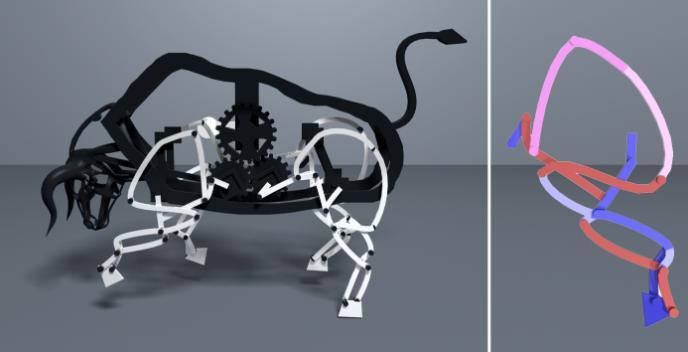There is little doubt in my mind that one day, probably not very far off, we will all have the ability to 3D print robotics and other forms of machinery within our own homes. No, I don’t mean T-800 robots from the  Terminator movies, but mechanical toys, and perhaps other useful devices which can easily be printed in one piece with gears and interconnected moving parts, all included. I will also daringly predict that within the next decade or so, integrated electronic components will be able to be printed within objects to create fully functional robotic devices straight from the 3D printer. In fact, we are already well on our way towards such a future.
Terminator movies, but mechanical toys, and perhaps other useful devices which can easily be printed in one piece with gears and interconnected moving parts, all included. I will also daringly predict that within the next decade or so, integrated electronic components will be able to be printed within objects to create fully functional robotic devices straight from the 3D printer. In fact, we are already well on our way towards such a future.
A team of researchers, including scientists from Disney Research Zurich, ETH Zurich and Columbia University have published a paper which overviews two incredible methods to automatically manipulate 3D models via a software. The software has the ability to integrate mechanical moving functions within an object. These models can then be 3D printed to allow for smooth, natural movement of the parts through manual mechanical manipulation.
“With the advent of 3D printers, the machinery for fabricating personalized mechanical toys, artifacts, or even robots becomes widely available,” states the paper. “Without the assistance of specialized software, however, designing such animated characters is a virtually impossible task for casual users.”
There are two main methods the researchers have come up with. The first is for a software called ChaCra which helps a user define a means of movement within planar mechanical characters, like that of shadow puppets. For instance, it would be a nightmare to try and come up with the proper design which would allow for a 3D printed model of a bird which can flap its wings via several different moving joints. The researchers have created an interactive software system which helps the user design planar mechanical characters similar to the shadow puppets you may see a puppeteer controlling, via sticks behind the scenes. Instead of sticks in the hands of a puppeteer, however, these designs will function from a single rotating actuator. Additionally, instead of spending hours trying to figure out the correct orientation and size of parts, to allow for a smooth effortless flow of movement within an object, the software allows a user to simply sketch an object, and pose it however they wish. The software will then figure out what modifications are needed and what mechanical structures need to be added. The process literally takes just minutes.

A motor (m) is selected and replaced with a new link(cnew) that connects components ca and cb. Small moment arms(middle) and short new links (right) are avoided by preventing the area of triangle (qb;m;qa) from becoming too small.
All the mechanical structures are devised based on three main mechanisms:
- Connectors – These are responsible for the relative motion between two parts
- Propagators – These are responsible for transmitting actuation from the source to the extremities
- Trimmers – These limit the range of a component to a pre-determined area
The other method is one which allows for the automation of designing linkage-based mechanical characters, which are able to move in a realistic, compelling manner.
“Despite the fact that the linkages are made from very basic components, they can create complex and often surprising motions,” Said Stelian Coros, a Disney Research Zurich research scientist.
Researchers start with a design for a mechanical object, of which the movement mechanisms are motors at each joint. The software then allows the user to replace the motor joints with rigid links which are able to ‘mechanically couple’ the motions of the various parts of the object. Such schematics would be extremely difficult to come up with if it were not for the software. Additionally, the tool will allow users to explore various different ways to link the motions, and help them in avoiding mechanical flaws which could hinder the object’s movement.
Such software allows for complex mechanical schematics to be placed within any object the user desires, allowing for simple 3D printing of mechanical designs. It’s only a matter of time before this type of software develops even further capabilities, providing the ability to design complex robotic and mechanical systems for anyone who can simply sketch out a drawing. Disney’s interest in such a software may possibly indicate a long-term interest in allowing for the 3D printing of mechanical characters which they may have trademarks on.
Let’s hear your thoughts on these new design tools in the mechanical 3D design software forum thread on 3DPB.com. Check out the video below, released by Disney Research explaining these tools in further detail.
[Source: DisneyResearch.com]Subscribe to Our Email Newsletter
Stay up-to-date on all the latest news from the 3D printing industry and receive information and offers from third party vendors.
You May Also Like
Precision at the Microscale: UK Researchers Advance Medical Devices with BMF’s 3D Printing Tech
University of Nottingham researchers are using Boston Micro Fabrication‘s (BMF) 3D printing technology to develop medical devices that improve compatibility with human tissue. Funded by a UK grant, this project...
3D Printing Webinar and Event Roundup: April 21, 2024
It’s another busy week of webinars and events, starting with Hannover Messe in Germany and continuing with Metalcasting Congress, Chinaplas, TechBlick’s Innovation Festival, and more. Stratasys continues its advanced training...
3D Printing Webinar and Event Roundup: March 17, 2024
It’s another busy week of webinars and events, including SALMED 2024 and AM Forum in Berlin. Stratasys continues its in-person training and is offering two webinars, ASTM is holding a...
3D Printed Micro Antenna is 15% Smaller and 6X Lighter
Horizon Microtechnologies has achieved success in creating a high-frequency D-Band horn antenna through micro 3D printing. However, this achievement did not rely solely on 3D printing; it involved a combination...































